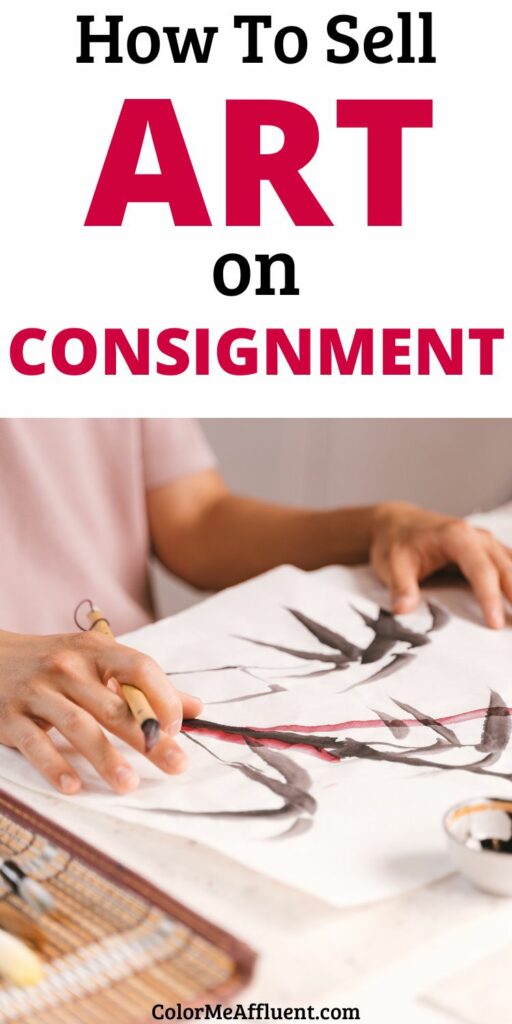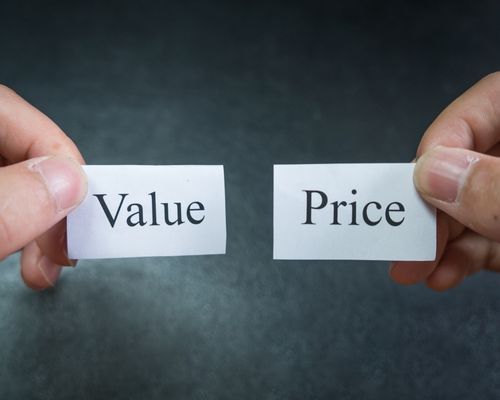How To Sell Art On Consignment: 10 Tips And Ideas For Sellers
Do you need to know how to sell art on consignment?
These days, most artists believe retailers prefer not to invest cash in art purchases.
However, that’s not exactly true:
Selling your art on consignment is still worth the effort.
Let’s talk about that in detail, shall we?
Recommended Read:
- How To Sell Art Online
- Best Websites To Sell Your Art
- 10 Tricks To Sell More Art
- Step-By-Step Guide To Selling Paintings On Amazon
- How To Start A Successful Art Business
How Does Selling Art On Consignment Work?
Before I show you how to sell art on consignment, you need to understand how such a process works.
Assuming that most aspiring artists have no idea what’s behind consignment as a term, I’ll begin by explaining it:
To sum up, consignment is an agreement between an artist and a gallery.
According to this agreement, the artist (you) will provide the gallery (or the retailer) artwork to sell.
Once that work of art sells, you’ll receive a percentage of the retail price, and the gallery’s owner will get the rest.
Typically, artists keep 70% of the profits, while the gallery receives 30%.

These days, you can get into consignment agreements with different businesses, such as galleries, restaurants, and even coffee shops.
It’s worth mentioning that well-established galleries won’t agree on consignment for anything less than 50% of the profits.
Pros And Cons Of Art Consignment
Pros:
- An opportunity to make money: Taking part in an art consignment will increase your chances of making an art sale.
- Another source of revenue: While there are many ways to make money as an artist, the art consignment process will add a brand new source of income to your art business and deserves careful consideration.
- High profits: On many occasions, artists can negotiate up to 80% profit share in an art consignment.
- Better reach to the audience and potential clients: Commercial consignment galleries attract thousands of art collectors – your pieces of art have an excellent chance to sell.
Cons:
- Extra expenditures: If your artwork fails to sell, you won’t make any money, and the consigning artist might have to cover shipping costs.
How To Sell Art On Consignment: Tips And Ideas To Help You Sell Your Artwork
1) Why Do You Want To Sell Your Art Work?
Chances are, you’re aware that answering the question of why is crucial when starting a business:
By all means, you need to know your why before the audience can learn more about it.
In other words, why do you need to sell the specific piece of art you have in mind through a common practice like consignment to find the right buyer?
Are you trying to get rid of it for a quick buck? Does this original artwork not align with the rest of your body of work? Or maybe the artwork is not even an original piece of yours – sometimes, art comes from the generations.
Whatever the answer to that question is, you need to know it before getting into your first art consignment.
2) How Do You Sell Your Art?
What methods have you implemented to make art sales and reach potential buyers?
Do you sell your art on the Facebook Marketplace? Is Instagram the playground that brings you constant art sales?
And what about Etsy? Is your art a good fit for Etsy’s audience?
As you can see, many places exist to sell art online and get a fair price.
Besides, many artists still sell their work locally by building professional relationships and without using consignment shops.
Anyhow, the point here is simple:
Above all, finding out how to sell art on consignment will serve you well only if it makes sense for your business.
Related Read:
- Should You Sell Art On eBay
- How To Sell Art On RedBubble
- Market Your Art On Displate
- Guide To Selling On Fine Art America
- Sell Art On Shopee
3) Know The True Value Of Your Art

Let’s face it – there is no worse feeling in the world for an artist than the one they get when their artwork is underpaid and not getting fair market value or the best price possible.
Then again, going in the opposite direction (overpricing your art) will not do you any favors either.
To avoid finding yourself in these two unfavorable situations, you’ll need to know the value of the piece you want to sell.
I suggest doing in-depth research that will help you determine the best price for the artwork you plan to sell through a consignment.
4) Learn Everything About How Selling On Auctions Works
Quite frankly, doing your homework is necessary no matter what kind of business you’re trying to build.
Subsequently, that rule applies to art business owners as well:
Don’t think about getting into an art consignment seller’s agreement before you learn everything there is to know on this topic.
For example, you can start the learning process by researching an auction house or art gallery you might want to work with at a later date. Furthermore, you should sign up for their newsletters and follow them on Social Media.
Long story short, gather as much information about a gallery’s target audience before you agree to an art consignment.
5) Go To A Few Art Sales
Nothing beats the first-hand experience – we can all agree on that.
Attending at least a couple of art sales will give you the personal experience you need to make up your mind about whether you should work with a gallery or not.
Witnessing how potential buyers review and value a piece of art before investing in it will give you detailed information and insights to prepare you for your first consignment in the art world.
6) Make Sure The Art Consignment Contract Is Good
OK, what does this even mean?
How are you supposed to ensure that your art consignment contract is fair and will be in your business’s best interest?
Here are a couple of elements the art consignment contract (or sample consignment agreement) has to include:
- Your name and contact information (personal data)
- Contact details of the establishment you’ll work with (name, phone number, email address, etc.)
- Contract clear terms (drop-off and pick-up date in case your art failed to sell, consignment period)
- Description of your artwork (title, size, etc.)
- Final sales Price and commission size for both parties involved (resale price and seller’s commission)
- Ways of payment
- Proof of ownership on your part
- Insurance requirements
- Any exclusivity clause you see fit
7) Document Everything
Since you’re here to learn how to sell art on consignment, I want to direct your attention to a crucial step in that process – the documenting part.
Why documenting artwork is necessary with art consignment?
The reason is that many artists get into art consignment to sell more than one piece of art.
If you plan to sell many an art collection at once (or your whole artwork archive), you should create copies of the paperwork that goes with each piece.
8) Mind The Seasonal Art And The Art In Demand
Certain artworks sell better in a specific season (Christmas-themed paintings are one example).
So, entering an art consignment to sell such artworks during the relevant season will double your chances of making a sale at higher prices.
The same goes for artworks constantly in demand – don’t offer them for a sale price under their market value.
9) Choose The Right Auction House

Without further ado, here are all the aspects you’ll need to question to help you choose the right auction house for an art consignment:
- Tools: Does the auction house have the right tools to sell your artwork?
- Experience: How much experience does the auction house have in this work?
- Marketing: What strategies the auction house plans to use to market your art?
- Pool Of Buyers: Are the right people visiting the products of the house?
- Working Terms: Can you find better agreement terms elsewhere?
- Payout Period: Is the payout period after making an art sale too long?
- Odd: Do you think the auction house has the best chance to sell your art piece among other competitors in the field?
10) Consult With Consignors
Alright, what do you have to do if you can’t decide whether you should enter an art consignment with any gallery, auction house, or another business?
Consulting with a consignor seems like the best thing to do:
Getting advice from someone who knows the process of selling art on consignment will be invaluable to you.
How To Sell Art On Consignment – Frequently Asked Questions
What Does It Mean When Art Is On Consignment?
To consign an artwork means sending it to an agent, gallery, or auction house that will sell it on your behalf.
What Percentage Do Most Consignment Shops Take?
These days, most consignment shops get to keep between 40-50% of the retail price of the artwork.
Of course, you can negotiate a higher percentage of profits – some artists keep up to 80%.
What Items Sell Best On Consignment?
- Artwork
- Unique items
- Modern furniture
- Dining sets
- Contemporary lamps
Final Say
Do you understand how to sell art on consignment after reading this article?
Hopefully, you do:
By all means, the process is not that difficult and can prove profitable if you do your homework and choose the best art consignment option for your business.
Now, what questions do you have on this topic?
Write them down in the comments section below, and I’ll answer them as soon as I can.
Related Articles You Might Like:
- Follow These 10 Steps To Make An Art Portfolio
- How To Use TikTok As An Artist
- In-Depth Guide To Selling Art On Pinterest
- Sell Art On Zazzle
- What Art Sells Best
- Top Ideas To Market Yourself As An Artist
- Guide To Selling Art On DeviantArt
- Best Ways To Promote Your Art
- Passive Income Ideas For Art Sellers
- Earn Money Selling Digital Art Online
- Free And Paid eCommerce Sites For Artists
- ArtPal Review
- Sell Art On Society6
- Saatchi Art Review